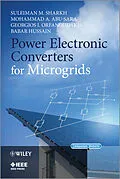As concerns about climate change, energy prices, and energy security loom, regulatory and research communities have shown growing interest in alternative energy sources and their integration into distributed energy systems. However, many of the candidate microgeneration and associated storage systems cannot be readily interfaced to the 50/60 Hz grid. In Power Electronic Converters for Microgrids, Sharkh and Abu-Sara introduce the basics and practical concerns of analyzing and designing such micro-generation grid interface systems. Readers will become familiar with methods for stably feeding the larger grid, importing from the grid to charge on-site storage, disconnecting from the grid in case of grid failure, as well as connect multiple microgrids while sharing their loads appropriately. Sharkh and Abu-Sara introduce not only the larger context of the technology, but also present potential future applications, along with detailed case studies and tutorials to help the reader effectively engineer microgrid systems.
Autorentext
S. M. Sharkh is a Senior Lecturer at the School of
Engineering Sciences, University of Southampton and the Managing
Director of HiT Systems Ltd, which specializes in electromagnetic
system analysis and design, control systems and web applications.
He has approximately 17 years research experience in electrical and
electromagnetic systems, and has been awarded numerous research
grants leading to commercialized products in a number of related
areas: grid connected PWM inverters, electric machines in harsh
environments (high-speed, high temperature, high pressure,
corrosive chemicals, submerged in liquids or underwater) PM
machines (axial gap dc machines, VRPM transverse flux
machines), characterization of and management of lithium ion
batteries, sensorless control of PM machines, novel
structurally integrated electric machines for marine thrusters and
electromagnetic losses in high-speed machines, and microgrid
intefaces. Sharkh has lectured on the subject of grid-connected
inverters and their control to both undergraduate and postgraduate
students, as well as companies. He holds a BEng and PhD in
electrical engineering from the University of Southampton.
M. A. Abu-Sara works with Bowman Power Systems, where he is
the lead engineer in designing and developing systems for
micro-generation. He holds a PhD in Electrical Engineering from the
University of Southampton.
Inhalt
About the Authors xi
Preface xiii
Acknowledgments xv
1 Introduction 1
1.1 Modes of Operation of Microgrid Converters 2
1.1.1 Grid Connection Mode 2
1.1.2 Stand-Alone Mode 3
1.1.3 Battery Charging Mode 3
1.2 Converter Topologies 4
1.3 Modulation Strategies 6
1.4 Control and System Issues 7
1.5 Future Challenges and Solutions 9
References 10
2 Converter Topologies 13
2.1 Topologies 13
2.1.1 The Two-Level Converter 13
2.1.2 The NPC Converter 14
2.1.3 The CHB Converter 15
2.2 Pulse Width Modulation Strategies 16
2.2.1 Carrier-Based Strategies 17
2.2.2 SVM Strategies 22
2.3 Modeling 27
References 28
3 DC-Link Capacitor Current and Sizing in NPC and CHB Inverters 29
3.1 Introduction 29
3.2 Inverter DC-Link Capacitor Sizing 30
3.3 Analytical Derivation of DC-Link Capacitor Current RMS Expressions 32
3.3.1 NPC Inverter 33
3.3.2 CHB Inverter 36
3.4 Analytical Derivation of DC-Link Capacitor Current Harmonics 37
3.4.1 NPC Inverter 38
3.4.2 CHB Inverter 39
3.5 Numerical Derivation of DC-Link Capacitor Current RMS Value and Voltage Ripple Amplitude 41
3.6 Simulation Results 42
3.7 Discussion 45
3.7.1 Comparison of Capacitor Size for the NPC and CHB Inverters 45
3.7.2 Comparison of Presented Methods for Analyzing DC-Link Capacitor Current 46
3.7.3 Extension to Higher-Level Inverters 48
3.8 Conclusion 48
References 48
4 Loss Comparison of Two- and Three-Level Inverter Topologies 51
4.1 Introduction 51
4.2 Selection of IGBT-Diode Modules 53
4.3 Switching Losses 54
4.3.1 Switching Losses in the Two-Level Inverters 54
4.3.2 Switching Losses in the NPC Inverter 57
4.3.3 Switching Losses in the CHB Inverter 58
4.4 Conduction Losses 58
4.4.1 Conduction Losses in the Two-Level Inverter 60
4.4.2 Conduction Losses in the NPC Inverter 61
4.4.3 Conduction Losses in the CHB Inverter 63
4.5 DC-Link Capacitor RMS Current 65
4.6 Results 69
4.7 Conclusion 70
References 71
5 Minimization of Low-Frequency Neutral-Point Voltage Oscillations in NPC Converters 73
5.1 Introduction 73
5.2 NPC Converter Modulation Strategies 74
5.3 Minimum NP Ripple Achievable by NV Strategies 77
5.3.1 Locally Averaged NP Current 78
5.3.2 Effect of Switching Constraints 79
5.3.3 Zero-Ripple Region 81
5.3.4 A Lower Boundary for the NP Voltage Ripple 81
5.4 Proposed Band-NV Strategies 83
5.4.1 Criterion Used by Conventional NV Strategies 83
5.4.2 Proposed Criterion 84
5.4.3 Regions of Operation 85
5.4.4 Algorithm 88
5.4.5 Switching Sequences Conversion to Band-NV 90
5.5 Performance of Band-NV Strategies 91
5.5.1 NP Voltage Ripple 91
5.5.2 Effective Switching Frequency Output Voltage Harmonic Distortion 93
5.6 Simulation of Band-NV Strategies 94
5.7 Hybrid Modulation Strategies 100
5.7.1 Proposed Hybrid Strategies 101
5.7.2 Simulation Results 102
5.8 Conclusions 106
References 107
6 Digital Control of a Three-Phase Two-Level Grid-Connected Inverter 109
6.1 Introduction 109
6.2 Control Strategy 112
6.3 Digital Sampling Strategy 113
6.4 Effect of Time Delay on Stability 115
6.5 Capacitor Current Observer 116
6.6 Design of Feedback Controllers 119
6.7 Simulation Results 121
6.8 Experimental Results 123
6.9 Conclusions 127
References 128
7 Design and Control of a Grid-Connected Interleaved I...
